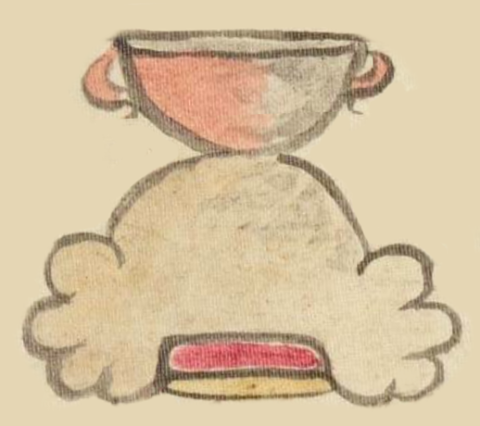Apazco (Azca14)
This painting of the compound glyph for the place name Apazco (“In the Cup” or “In the Bowl”) has two elements. One is the sign of a hill or mountain (tepetl) with the horizontal yellow and red slits at the bottom where spring water (atl) could emerge. The tepetl has the curling shapes of the ends of a stone (tetl). This bell-shaped landscape feature might also be interpreted here as an altepetl, a socio-political unit. The other element of this compound is a cup or bowl (apaztli) with a handle on the left and another one on the right, both near the lip. The cup is dark pink on the left side and gray on the right. Perhaps the tlacuilo was providing shading for three-dimensionality. The handles are pink, too. The hill is light brown and gray; again, the gray may intend shading. The locative suffix (-co) may be implied in the hill.
Stephanie Wood
The gloss here states that the Mexica founded this settlement. It is one of many founded on the migratory journey that would end with the founding of Mexico-Tenochtitlan.
Stephanie Wood
apasco motlallico in mexica
Apazco omotlalico in Mexica
Stephanie Wood
post-1550, possibly from the early seventeenth century.
Jeff Haskett-Wood
tazas, cuencos, vasijas, recipiente, pueblos, topónimos, nombres de lugares

apaz(tli), earthen bowl, cup, container, https://nahuatl.wired-humanities.org/content/apaztli
-co (locative suffix), in, on, or at, https://nahuatl.wired-humanities.org/content/co
En el Cuenco, or En el Apaxtle
Stephanie Wood
The Codex Azcatitlan is also known as the Histoire mexicaine, [Manuscrit] Mexicain 59–64. It is housed in the Bibliothèque Nationale de France, and hosted on line by the World Digital Library and the Library of Congress, which is “unaware of any copyright or other restrictions in the World Digital Library Collection.”
https://www.loc.gov/resource/gdcwdl.wdl_15280/?sp=14&st=image
The Library of Congress is “unaware of any copyright or other restrictions in the World Digital Library Collection.” But please cite Bibliothèque Nationale de France and this Visual Lexicon of Aztec Hieroglyphs.



